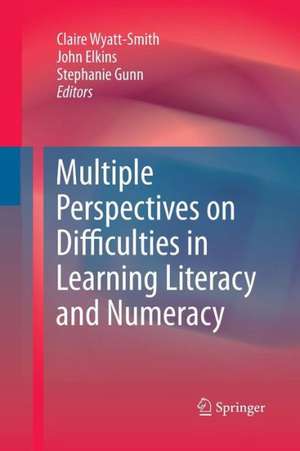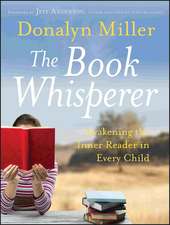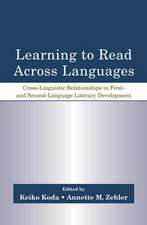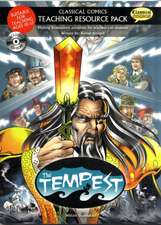Multiple Perspectives on Difficulties in Learning Literacy and Numeracy
Editat de Claire Wyatt-Smith, John Elkins, Stephanie Gunnen Limba Engleză Paperback – 2 sep 2014
| Toate formatele și edițiile | Preț | Express |
|---|---|---|
| Paperback (1) | 949.42 lei 6-8 săpt. | |
| SPRINGER NETHERLANDS – 2 sep 2014 | 949.42 lei 6-8 săpt. | |
| Hardback (1) | 955.56 lei 6-8 săpt. | |
| SPRINGER NETHERLANDS – 5 noi 2010 | 955.56 lei 6-8 săpt. |
Preț: 949.42 lei
Preț vechi: 1157.82 lei
-18% Nou
Puncte Express: 1424
Preț estimativ în valută:
181.70€ • 188.99$ • 149.100£
181.70€ • 188.99$ • 149.100£
Carte tipărită la comandă
Livrare economică 14-28 aprilie
Preluare comenzi: 021 569.72.76
Specificații
ISBN-13: 9789400798946
ISBN-10: 9400798946
Pagini: 400
Ilustrații: XXII, 375 p.
Dimensiuni: 155 x 235 x 21 mm
Greutate: 0.56 kg
Ediția:2011
Editura: SPRINGER NETHERLANDS
Colecția Springer
Locul publicării:Dordrecht, Netherlands
ISBN-10: 9400798946
Pagini: 400
Ilustrații: XXII, 375 p.
Dimensiuni: 155 x 235 x 21 mm
Greutate: 0.56 kg
Ediția:2011
Editura: SPRINGER NETHERLANDS
Colecția Springer
Locul publicării:Dordrecht, Netherlands
Public țintă
ResearchCuprins
Contents.- Acknowledgements.- About the contributors.- List of figures.- List of tables.- Chapter 1: Theoretical frameworks and ways of seeing: Operating at the intersection—literacy, numeracy and learning difficulties.- Chapter 2: Learning difficulties, literacy and numeracy: Conversations across the fields.- Chapter 3: Researching the opportunities for learning for students with learning difficulties in classrooms: An ethnographic perspective.- Chapter 4: The new literacies of online reading comprehension: New opportunities and challenges for students with learning difficulties.- Chapter 5: Literacy, technology and the Internet: What are the challenges and opportunities for learners with reading difficulties, and how do we support them in meeting those challenges and grasping those opportunities?.- Chapter 6: Essential provisions for quality learning support: Connecting literacy, numeracy and learning needs.- Chapter 7: Reading the home and reading in school: Framing deficit constructions as learning difficulties in Singapore English classrooms.- Chapter 8: Parent, family and community support for addressing difficulties in literacy.- Chapter 9: Enhancing reading comprehension through explicit comprehending strategy teaching.- Chapter 10: The writing achievement, metacognitive knowledge of writing and motivation of middle-school students with learning difficulties.- Chapter 11: The role of self-monitoring in initial word recognition learning.- Chapter 12: Effective instruction for older, low-progress readers: Meeting the needs of Indigenous students.- Chapter 13: Actualising potential in the classroom: Moving from practising to be numerate towards engaging in the literate practice of mathematics.- Chapter 14: Effective instruction in mathematics for students with learning difficulties.- Chapter 15: Language, culture and learning mathematics: A Bourdieuian analysis of Indigenous learning.- Chapter 16: ‘She’s not in my head or in my body’: Developingidentities of exclusion and inclusion in whole-class discussions.- Chapter 17: Breaking down the silos: The search for an evidentiary base.- Index.
Recenzii
From the reviews:
“This book is likely to be found soon on all recommended reading lists for graduate and postgraduate students pursuing studies in special and inclusive education. It is also relevant reading for students undertaking courses in the teaching of reading and mathematics. … brings together under one cover the diverse theories, perspectives and studies that have hitherto been confined to discipline-specific texts and professional journals. … the book has probably achieved its purpose in advancing our understanding of issues surrounding learning difficulties in literacy and numeracy.” (Peter Westwood, Australian Journal of Learning Difficulties, Vol. 17 (1), May, 2012)
“This book is likely to be found soon on all recommended reading lists for graduate and postgraduate students pursuing studies in special and inclusive education. It is also relevant reading for students undertaking courses in the teaching of reading and mathematics. … brings together under one cover the diverse theories, perspectives and studies that have hitherto been confined to discipline-specific texts and professional journals. … the book has probably achieved its purpose in advancing our understanding of issues surrounding learning difficulties in literacy and numeracy.” (Peter Westwood, Australian Journal of Learning Difficulties, Vol. 17 (1), May, 2012)
Textul de pe ultima copertă
This book advances understandings of the difficulties in learning that students experience in the key areas of literacy and numeracy and the interventions that have been used to improve outcomes. By including authors drawn from several countries and with expertise in a variety of research traditions, the book addresses the sometimes complementary and sometimes contradictory results, and generates new approaches to understanding and serving students with difficulties in literacy and numeracy.A distinctive feature of the book is its focus at the intersection of literacy education, numeracy education and learning difficulties. Traditionally these have tended to be addressed separately by researchers and policy makers, leading to compartmentalised thinking and often demonstrates lack of awareness of developments in the other domains. In short, to date there has been limited exchange across these fields. Further, the published research and indeed policy attention indicates a relative imbalance given to literacy and numeracy education and learning difficulties relative to these more generally. The authors in this book respond to this by providing a more balanced coverage of these fields and extend the discussion into the contribution of information and communication technologies.This book brings together for the first time internationally recognised scholars from a diverse range of countries whose contributions provide an opening for new insights into difficulties in learning literacy and numeracy from a range of educational policy and practice contexts.
Caracteristici
Focusses at the intersection of literacy education, numeracy education and learning disabilities traditionally these have tended to be addressed separately by researchers and policy makers Draws upon diverse theoretical perspectives in the common goal of improved learning especially for students who are struggling to achieve expected standards With contributions by international experts







